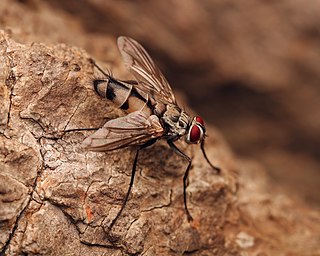
The Tachinidae are a large and variable family of true flies within the insect order Diptera, with more than 8,200 known species and many more to be discovered. Over 1,300 species have been described in North America alone. Insects in this family commonly are called tachinid flies or simply tachinids. As far as is known, they all are protelean parasitoids, or occasionally parasites, of arthropods, usually other insects. The family is known from many habitats in all zoogeographical regions and is especially diverse in South America.

The Colorado potato beetle is a beetle known for being a major pest of potato crops. It is about 10 mm long, with a bright yellow/orange body and five bold brown stripes along the length of each of its elytra. Native to the Rocky Mountains, it spread rapidly in potato crops across America and then Europe from 1859 onwards.
Gymnoclytia occidentalis is a North American species of tachinid flies in the genus Gymnoclytia of the family Tachinidae.
Gymnosoma amplifrons is a Nearctic species of fly in the family Tachinidae.
Gymnosoma canadense is a Nearctic species of fly in the family Tachinidae.
Celatoria is a genus of flies in the family Tachinidae. Larvae are parasitoids of leaf beetles.

Myiopharus is a genus of flies in the family Tachinidae.
Ligeria latigena is a North America species of fly in the family Tachinidae.

Lebia grandis is a ground beetle in the family Carabidae found in North America. It is a specialist predator on the eggs and larvae of Colorado potato beetles, and its larvae are obligate parasitoids of Colorado potato beetle pupae.
Chaetocrania antennalis is a species of fly in the family Tachinidae.
Phasia aldrichii is a tachinid fly found throughout most of North America.

Compsilura concinnata is a parasitoid native to Europe that was introduced to North America in 1906 to control the population of an exotic forest, univoltine, spongy moth named Lymantria dispar. It is an endoparasitoid of larvae and lives with its host for most of its life. Eventually the parasitoid ends up killing the host and occasionally eating it. It attacks over 200 host species, mainly insects from the Orders: Coleoptera, Lepidoptera and Hymenoptera. Since this parasite has the ability to attack many different types of hosts, the organism has spilled over from the intended forest systems into other areas, like agricultural fields, affecting cabbage pests including the cabbage looper (Trichoplusia); the cabbage worm ; and even other invasive species such as the brown-tail moth. However, it also attacks native, non-pest insects such as the Cecropia moth and American moon moth.
Celatoria diabroticae is a species of bristle fly in the family Tachinidae.
Freraea montana is a species of bristle fly in the family Tachinidae.

Gonia crassicornis is a species of fly in the family Tachinidae.

Madremyia saundersii is a species of bristle fly in the family Tachinidae. It is a parasitoid of late-instar Choristoneura species, emerging from the sixth instar or pupal stage of its host.
Acantholespesia comstocki is a species of bristle fly in the family Tachinidae. Its larval hosts are Hesperiidae, Megathymidae and Pyralidae families of butterflies.

Atacta brasiliensis is a species of bristle fly in the family Tachinidae.
Thelairodoria setinervis is a species of bristle fly in the family Tachinidae.

Zelia vertebrata is a species of bristle fly in the family Tachinidae. It is a long-bodied fly with strong abdominal bristles and a distinctive abdominal pattern that resembles vertebrae. It has a widespread North American range, with records stretching from east to west from Washington to Maine, north to south from Québec to Florida. Its larval stage parasitizes beetles. It is most active during the day.









